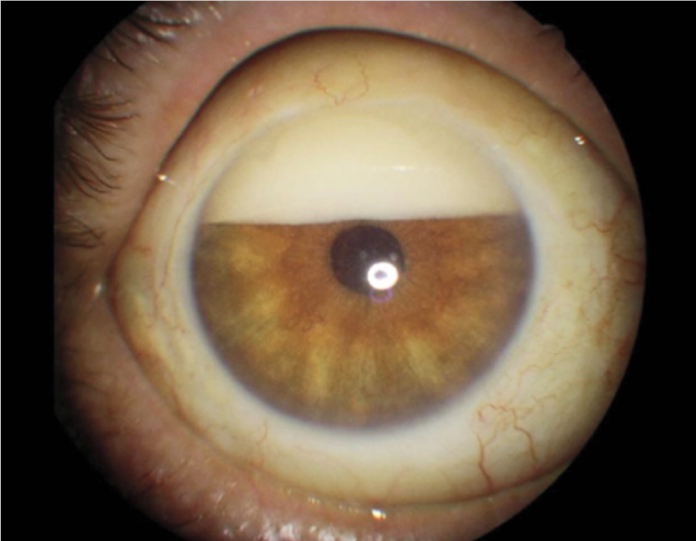A 69-year-old male, known case of non-insulin-dependent diabetes mellitus, had undergone cataract surgery and vitrectomy of the right eye for treatment of retinal detachment. After 3 years, he was diagnosed with hyperoleon. What is the possible cause?
The case itself has the answer to the question. Three years after the surgery, he presented for a routine ocular examination. A white layer was seen covering the upper third of the iris of the right eye.
The left eye had a visual acuity of 20/40, and the right eye’s VA was 20/400.
On slit-lamp examination of the right eye, an emulsified layer of silicone oil (SO) was noticed in the anterior chamber along with mild corneal edema. The emulsified SO layer moved as the patient tilted his head. The intraocular pressure was normal, and the lens was covered with pigmentary deposits.
Surgery was performed to remove the SO, which consequently improved the right eyes’ visual acuity to 20/80.
At the 6-month follow up visit, the patient had no active complaints, nor was there a recurrence of retinal detachment.
The emulsification of the silicone oil layer is known as hyperoleon. To answer the question as to what causes hyperoleon:
During the vitreous surgery for retinal detachment, silicone (polymethysiloxane) oil is used as retinal tamponade. But the use of SO is not without the associated complications. Prolonged use of SO within the eye might lead to emulsification, migration/displacement, optic neuropathy, band keratopathy, changes in the intraocular pressure, etc.
Out of these complications, the patient in the discussion here presented with emulsification of the SO, also called hyperoleon or inverted hypopyon.
How to differentiate between hyperoleon and hypopyon:
Hyperoleon is the emulsification of the silicone oil, whereas hypopyon is an inflammatory/infective process that manifests as deposition of pus and hemorrhage. Also, hyperoleon or inverted hypopyon, as the name suggests, appears superiorly. This is because the density of silicone oil is lower than that of aqueous humor, whereas hypopyon is seen in the inferior part of the anterior chamber.
What is shown in the image below?

What about this image?

Image Source: University of Iowa Health Care
When to treat?
Hyperoleon is an indication for the surgical removal of the silicone oil.
Why use silicone oil when its complications are known?
Silicone oil, as retinal tamponade, is a choice because of its transparency which doesn’t obstruct the posterior segment surgical fields, and because of its ability to provide permanent/prolonged tamponade as compared to gas tamponade.
References
Donato Colantuono, M. a. (2020, May 28). Hyperoleon. Retrieved from The New England Journal of Medicine: https://www.nejm.org/doi/full/10.1056/NEJMicm1914376
Mester U, Knaflic D. Olej sylikonowy w chirurgii odwarstwienia siatkówki–wskazania i doświadczenia kliniczne [Silicone oil in the surgical treatment of retinal detachment–indications and clinical experience]. Klin Oczna. 1991;93(7-8):211-214.




